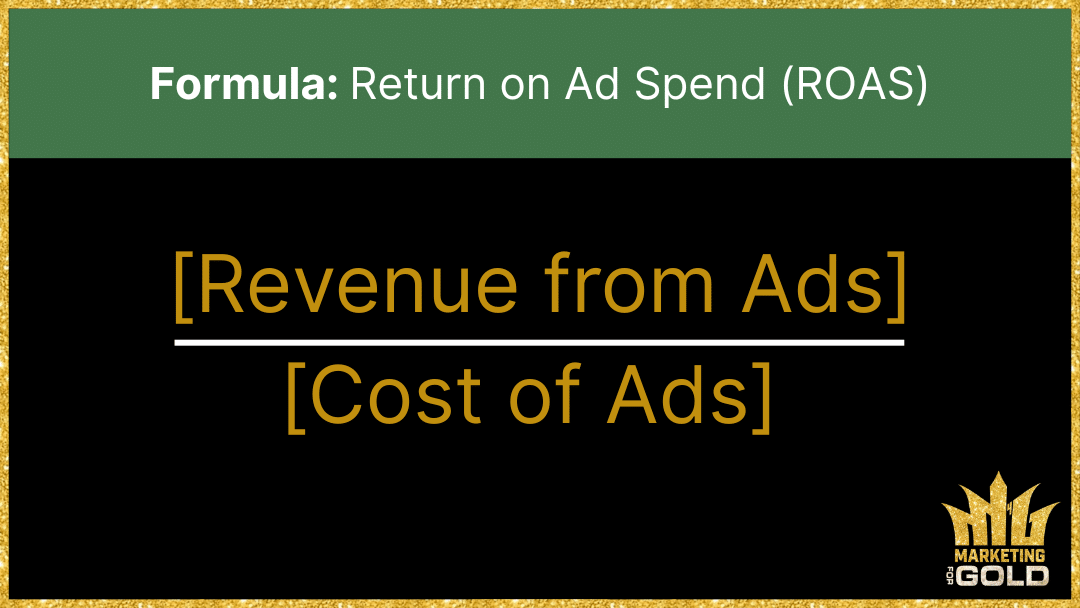Why Knowing the ROAS Formula Is Just the Start: How B2B Leaders Unlock True Marketing ROI
For B2B product and tech companies in the $5–$35 million range, senior leaders are under constant pressure to prove that marketing is more than just a cost center. It’s an investment meant to generate clear, measurable returns. So it makes sense that many CEOs, Presidents, Heads of Marketing, Fractional CMOs, VPs of Marketing, and COOs start with a simple question:
“What’s our ROAS?”
Understanding the ROAS formula — your Return on Ad Spend — is often the first step toward answering that. It tells you, in its simplest form:

A ratio of 5:1 means you earn five dollars in revenue for every dollar spent on advertising.
Useful? Absolutely. But it’s only the beginning.
Because here’s the challenge many growing B2B companies face: while the ROAS formula helps you see what came back from what you put into paid ads, it doesn’t tell you the whole story about your marketing performance. And stopping there can cost you far more than you realize.
In this article, we’ll explore:
- Why knowing the ROAS formula matters — but why it can’t stand alone
- The real-world problems B2B leaders experience without a complete reporting system
- How a comprehensive marketing reporting system gives clarity, confidence, and growth potential far beyond ROAS
Why the ROAS Formula Matters (And Why It Falls Short)
Let’s start with why the ROAS formula is so popular:
- It’s simple: dollars in, dollars out.
- It feels objective.
- It helps justify ad budgets to CFOs and boards.
If your company spends $100,000 on Google Ads in Q3 and brings in $400,000 in attributed revenue, your ROAS is 4:1. Clear, easy to calculate, and seemingly actionable. But for B2B companies with complex sales cycles, multiple touchpoints, and long buyer journeys, ROAS only shows one slice of the picture:
- It usually only measures last-click or platform-attributed revenue.
- It ignores organic search, content, partnerships, email nurture, and trade shows.
- It doesn’t explain which ads or creative drove qualified leads, not just clicks.
Most importantly, it can’t tell you if your marketing spend actually supported your strategic goals — like entering a new vertical, increasing deal size, or shortening sales cycles. Furthermore, according to Lead Forensics, ‘70% of B2B marketers report facing pressure to demonstrate marketing ROI. This highlights the growing need for marketers to quantify the impact of their efforts and justify marketing spend.’

The Hidden Problems of Relying Only on the ROAS Formula
For senior B2B leaders, stopping at the ROAS formula leads to recurring problems:
1. Decisions Based on Incomplete Data
Without a comprehensive marketing reporting system, data ends up fragmented across platforms: Google Ads, LinkedIn, HubSpot, Salesforce, Excel spreadsheets.
This leaves CEOs and Heads of Marketing making high-stakes decisions based on gut instinct or partial dashboards. As a result:
- High-impact strategies may be underfunded because their value isn’t fully visible.
- Ineffective tactics can keep draining budget because they “look good” in a narrow ROAS view.
2. Blind Spots in the Funnel
The ROAS formula measures ad spend return — but ignores what happens after the click:
-
- How many of those leads fit your ideal customer profile?
- What percentage converted to opportunities?
- How many reached closed-won?
For B2B product and tech companies with long, complex sales cycles, these questions are essential to knowing what truly drives revenue.
3. Difficulty Communicating ROI to Boards and Investors
Senior executives often need to justify marketing spend beyond “our ROAS is 3:1.”
Boards want answers like:
-
- “Which channels delivered the highest lifetime value customers?”
- “How much pipeline did marketing generate?”
- “Where are the bottlenecks in our funnel?”
When the only number you have is ROAS, those conversations become defensive instead of strategic.
4. Missing the Big Picture
The ROAS formula measures revenue relative to paid ad spend — but it doesn’t track:
- Content marketing performance (which per Firework, 73% of B2B marketers say drives highest ROI)
- Referral and partner marketing
- Event and webinar impact
- Multi-touch journeys
Without these, senior leaders can’t see which tactics really move the needle.
What a Comprehensive Marketing Reporting System Looks Like
At Marketing for Gold, we see the difference every day between companies who stop at the ROAS formula — and those who build a full marketing reporting system.
A comprehensive system typically includes:
- Full-funnel reporting: Tracks dollars in and dollars out across all channels, from MQLs and SQLs to closed revenue.
- Unified dashboards: Pulls data from CRM, marketing automation, ad platforms, and even offline efforts.
- Attribution modeling: Moves beyond last click to reveal how different touchpoints combine to close deals.
- Pipeline visibility: Measures not just revenue, but deal stages, average sales cycle, and lead quality.
- Custom reports for leadership: Provides strategic insights for CEOs and COOs, not just raw numbers.
With this in place, marketing leaders shift from reactive adjustments to proactive strategy.
The Strategic Shift: From ROAS to ROI Clarity
Imagine these two scenarios:
Scenario A: Only Using ROAS
A CEO sees a 2:1 ROAS on Google Ads and says, “We should cut spend — that’s too low.”
But they miss that:
- Ads drove highly qualified leads with large deal sizes.
- Those deals are still in the pipeline, likely to close next quarter.
- Organic content nurtured leads that eventually converted through paid retargeting.
Scenario B: Comprehensive Reporting
The CEO sees:
-
- A lower ROAS on top-of-funnel ads, but strong pipeline contribution.
- High conversion rates from organic leads to closed-won.
- A content piece that influenced multiple large deals.
Instead of cutting spend, they invest more strategically, increasing pipeline and revenue.
Why B2B Companies Get Stuck — And How to Move Forward
For $5–$35M product and tech companies, typical obstacles include:
- Data scattered across tools with no integration.
- Manual, error-prone spreadsheets.
- Lack of internal analytics expertise.
- Leadership accustomed to looking only at ROAS.
Breaking through starts by recognizing the ROAS formula isn’t wrong — it’s just incomplete.

Start with the ROAS Formula — Then Build on It
Here’s how senior leaders can move from limited insight to comprehensive clarity:
-
- Calculate your current ROAS across all paid campaigns.
- Identify gaps: What revenue sources aren’t tracked? Where is data missing?
- Integrate systems: Connect CRM, ad platforms, and analytics tools.
- Track the entire funnel: From first click to closed deal.
- Build dashboards: Tailor insights for executives, not just marketers.
Conclusion: The ROAS Formula Is a Beginning, Not the Destination
For B2B product and tech companies, knowing the ROAS formula is useful — it helps see what paid ads return. But by itself, it can lead to short-term, reactive decisions and blind spots that slow growth.
A comprehensive marketing reporting system empowers leaders to:
- See the true ROI of every marketing effort
- Make confident, data-driven decisions
- Communicate marketing’s value to boards and investors
- Invest strategically for sustainable growth
At Marketing for Gold, we help companies build that system — so every dollar in and every dollar out is clear.
